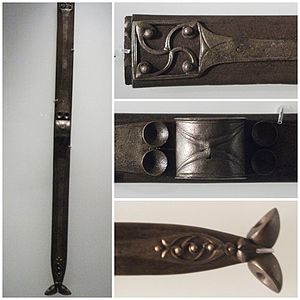- Scabbard
-
A scabbard is a sheath for holding a sword, knife, or other large blade. Scabbards have been made of many materials over the millennia, including leather, wood, and metals such as brass or steel.
Contents
Types of scabbards
Most commonly, scabbards were worn suspended from a sword belt or shoulder belt (baldric). Some shoulder belts held the scabbard diagonally across the back (see also Koshirae).
Ancient scabbards
Wooden scabbards were usually covered in fabric or leather, and leather versions also usually bore metal fittings for added protection and carrying ease. Japanese blades, however, typically have their sharp cutting edge protected by a wooden scabbard called a saya. Many scabbards like the ones the Greeks and Romans used were small and light. They were designed for holding the sword rather than protecting it. All-metal scabbards were popular items for a display of wealth among elites in the European Iron Age, and often intricately decorated. A number of ancient scabbards have been recovered from weapons sacrifices, a few of which had a lining of fur on the inside.[1] The fur was probably kept oily, keeping the blade free from rust. The fur would also allow a smoother, quicker draw.
Modern scabbards
Entirely metal scabbards became popular in Europe early in the 19th century and eventually superseded most other types. Metal was more durable than leather and could better withstand the rigors of field use, particularly among troops mounted on horseback. In addition, metal offered the ability to present a more military appearance, as well as the opportunity to display increased ornamentation. Nevertheless, leather scabbards never entirely lost favor among military users and were widely used as late as the American Civil War (1861-65).
Some military police forces, naval shore patrols, law enforcement and other groups used leather scabbards as a kind of truncheon.
Back scabbards were never used in European, Near East, or Indian military cultures, and depictions of such are a modern invention and have enjoyed great popularity in fiction and fantasy, to the point that they are widely believed to be a Medieval invention.[citation needed] A well-known example of this is the back scabbard depicted in the movie Braveheart. There is some limited data from woodcuts and textual fragments that Mongol light horse archers and some Chinese soldiers wore a slung baldric over the shoulder, allowing longer blades to be strapped across the back.
However in "The Ancient Celts" by Barry Cunliffe, on page 94 of that book, Professor Cunliffe writes,"All these pieces of equipment [shields, spears, swords, mail armour], mentioned in the texts, are reflected in the archaeological record and in the surviving iconography, though it is sometimes possible to detect regional variations. Among the Parisii of Yorkshire, for example, the sword was sometimes worn across the back and therefore had to be drawn over the shoulder from behind the head."
Common terms
The metal fitting where the blade enters the leather or metal scabbard is called the throat, which is often part of a larger scabbard mount, or locket, that bears a carrying ring or stud to facilitate wearing the sword. The blade's point in leather scabbards is usually protected by a metal tip, or chape, which on both leather and metal scabbards is often given further protection from wear by an extension called a drag, or shoe.
See also
References
- ^ p266 & p282 Lars Jorgensen et al 2003 The spoils of Victory - The north in the shadow of the Roman Empire Nationalmuseet (National Museum of Denmark)
External links
 Media related to Scabbards at Wikimedia CommonsCategories:
Media related to Scabbards at Wikimedia CommonsCategories:- Swords
- Blade weapons
Wikimedia Foundation. 2010.


